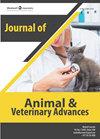Dietary and seasonal effects on body weight, ovarian development and blood reproductive hormone levels in peri-pubertal female camels (Camelus dromedarius)
引用次数: 0
Abstract
The aim of the present study was to investigate the effect of nutrition on body weight gain, ovarian development, blood components (total protein, albumen, globulin, cholesterol, glucose) and hormone (estradiol, progesterone, FSH, LH, GnRH and Leptin) levels in peri-pubertal female camels. Fourteen dromedary females (Camelus dromedarius) were divided into two groups (A and B) with respective average body weight and age of 381 kg, 24 months and 458 kg, 24 months at the start of the experiment. Group A received a diet with 13% Crude Protein (CP) and 2.9 Mcal Metabolizable Energy (ME). Group B received the traditional diet of the farm with 12.43 CP and 2.7 ME. Both diets contained 1:3 forage:concentrate ratio. Individual feed intake was calculated after a 14 days adaptation period. Feed offered and orts were recorded daily during the entire experimental period of 24 months. Blood samples were taken from the same 5 animals in each group at 15 day intervals throughout the experimental period. Hormone concentrations were measured using specific ELISA kits. Initial body weight, final body weight and average daily gain for the two treatment groups were not significantly different. Group B had greater ovarian size than group A but the difference was also non-significant. The size of the right ovary was less than the left ovary. Season had no significant effect on ovary's size. Group A camels tended to have higher blood estradiol, leptin, GnRh and LH levels than group B. However, the differences were not significant except in the case of estradiol. Progesterone and FSH levels were also comparable in the two groups. It was concluded that the feeding regimen used in this study did not significantly affect body weight, daily weight gain and blood progesterone level while a relative, though statistically non-significant, increase was recorded in blood estrogen, Leptin, GnRH and LH levels in group A. (Resume d'auteur)饮食和季节对青春期前后雌性骆驼体重、卵巢发育和血液生殖激素水平的影响
本研究旨在探讨营养对青春期前后雌性骆驼体重增加、卵巢发育、血液成分(总蛋白、白蛋白、球蛋白、胆固醇、葡萄糖)和激素(雌二醇、黄体酮、卵泡刺激素、黄体生成素、GnRH和瘦素)水平的影响。选取14头雌性单峰骆驼(Camelus dromedarius),试验开始时平均体重为381 kg(24月龄),平均年龄为458 kg(24月龄),分为A组和B组。A组饲粮的粗蛋白质(CP)为13%,代谢能(ME)为2.9。B组饲喂猪场传统饲粮,CP为12.43,ME为2.7。两种饲粮的粗精比均为1:3。预试期14 d后计算个体采食量。在整个24个月的试验期内,每天记录供料量和采食量。在整个实验期间,每组取5只动物的血样,每隔15天采集一次。采用特异性ELISA试剂盒测定激素浓度。两处理组的初始体重、最终体重和平均日增重无显著差异。B组卵巢大小大于A组,但差异无统计学意义。右卵巢体积小于左卵巢。季节对子房大小无显著影响。A组骆驼血液中的雌二醇、瘦素、GnRh和LH水平往往高于b组,但除雌二醇外,其他差异均不显著。两组的孕酮和卵泡刺激素水平也具有可比性。结论:本研究中采用的喂养方式对体重、日增重和血孕酮水平无显著影响,而a组血雌激素、瘦素、GnRH和LH水平有相对升高,但无统计学意义(Resume d’auteur)。
本文章由计算机程序翻译,如有差异,请以英文原文为准。
求助全文
约1分钟内获得全文
求助全文
来源期刊
自引率
0.00%
发文量
0
审稿时长
1 months
期刊介绍:
Journal of Animal Veterinary advances is a peer-reviewed, open-access scientific journal which publishes articles related to experiments, treatment, analysis, biological elements and other methods of research connected with veterinary. JAVA started publishing activity in 2002, since that time is updated twice a month, and is available in online and print formats. The publications are reviewed by Editorial Board in accordance with the standards and novelty of the subject, while strictly following ethical guidelines. Subject areas suitable for publication include, but are not limited to the following fields :: Veterinary science :: Animal husbandry :: Animal nutrition :: Anatomy :: Biological science :: Pathology :: Infectious diseases :: Animal physiology :: Animal breeding :: Animal biotechnology :: Transgenic animal production :: Animal parasitology :: Veterinary medicine :: Animal feed and nutrition :: Equine.

 求助内容:
求助内容: 应助结果提醒方式:
应助结果提醒方式:


